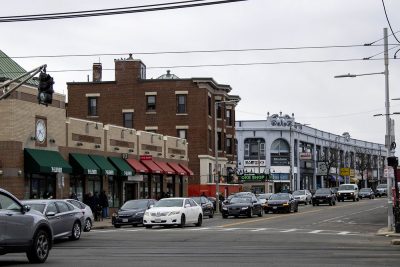The Boston City Council’s Committee on Planning, Development and Transportation convened Tuesday to discuss a new Allston-Brighton Master Plan and Zoning Initiative.

Councilors, representatives of City departments and members of the public discussed rising rents, sustainable development and racial housing disparities in the region.
Housing activists also attended, saying the City Council failed to protect residents against rising rents and rapid gentrification.
Natalícia Tracy, executive director of Boston’s Brazilian Worker Center, said new development threatens the neighborhood’s diversity, which is “vibrant in its character.”
“The housing and economic opportunities available in the emerging neighborhood are not affordable or accessible to most current residents,” Tracy said. “They threaten to make Allston more homogenous, let’s just say whiter.”
Tony D’Isidoro, president of the Allston Civic Association, said it was “reasonable and appropriate” to conduct a comprehensive review of the neighborhood’s development.
“Judgment day is approaching,” D’Isidoro said. “Projections of population and business loss due to the cost of living and the cost of doing business are real and profound.”
The City set a goal in 2014 to create 69,000 new housing units by 2030 — part of former Mayor Marty Walsh’s Boston 2030 plan.
In the past 10 years, more than 7,000 new units of housing have been approved in Allston-Brighton, according to the City Council hearing order filed Jan. 27.
Of those units, only 20% of them are homeownership units, while the rest are rentals, according to the hearing. The units being approved are primarily studio and one-bedroom apartments.
The hearing order also states that rent in the neighborhood has risen by around 32% in the last two years.
Richard Peiser, the Michael D. Spear professor of real estate development at Harvard University, said the issue of affordability primarily comes down to allowing the construction of higher-density units.
“There isn’t a magic bullet,” he said. “Boston’s an expensive place.”
Kevin Carragee, an Allston-Brighton resident since 1989 and professor at Suffolk University, said the neighborhood is a “community at risk,” adding that comprehensive development plans could be the antidote to a rapidly gentrifying neighborhood that continues to push out its lower- and middle-income residents.
“The question is, what kind of housing and who is it for?” he said in an interview.
Carragee noted that these problems are not just limited to Allston-Brighton’s lower-income residents, but extend “deep into the middle class.”
“I’m an enthusiastic supporter of this proposal,” Carragee said at Tuesday’s meeting. “Currently, the [Boston Planning and Development Agency] engages in a piecemeal approach in terms of development in this neighborhood and other neighborhoods, too. It’s essentially one project at a time.”
Carragee said the BPDA greenlit projects, including a housing proposal above the Stop & Shop supermarket development, despite opposition by community members and the City Council.
Eva Webster, a 30-year Brighton homeowner, said she feels homeowners and high-income residents are often “forgotten” in zoning discussions, which tend to focus on low-income households.
“It strikes me that only a certain part of our demographics are considered worthy of protection,” Webster said. “We feel so incredibly disenfranchised and frustrated that all politicians are only paying attention to the demographics that they think is going to bring them the most votes, but this is not the way to plan a neighborhood.”
Brighton resident Susan Rutkiewicz said she hopes her neighborhood doesn’t become “a city with tall buildings.”
“The housing units being built should be more attractive,” Rutkiewicz said. “I see brown, boxy buildings on Tremont Street in Brighton, and using nice colors and having gardens will make people happier.”
Peiser said affordable development does not have to conflict with the area’s historic charm.
“I don’t blame them, to a certain extent, because if they really have a nice residential character, you’d want to preserve that,” Peiser said. “Still, within those constraints, there are ways to increase the density without it really changing the character of the neighborhood.”
The majority of attendees spoke in support of the proposed initiative and offered their own suggestions to improve the plan.
“I’m confident that I speak on behalf of many, if not all, of our residents in saying that an Allston-Brighton master plan that is inclusive of expanded affordable housing options with supports for older adults is an urgent need and a really high priority,” said Lizbeth Heyer, chief of real estate and innovation at 2Life Communities, which operates several senior housing facilities in the region.
Carragee proposed implementing a “value capture” system in Boston — taxes that proportionally rise in response to publicly funded improvements such as to transit infrastructure, which increase local property values, and that money could be later funneled into projects that benefit the public, including affordable housing.
“There’s additional taxes linked to the increased value of the property,” Carragee said, “and that is used in some cities to finance affordable housing and other housing initiatives.”
Councilor Liz Breadon, who initially sponsored the hearing order, concluded the meeting by saying the “takeaway message” was that an upcoming master plan must consider affordability, green space, housing, sustainability and food access, among other areas.
“Planning is more than just about zoning,” Breadon said. “Planning is about envisioning a community that is inclusive, diverse and a great place to live, to raise a family to grow old, to work, to come to school.”
















































































































